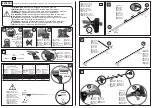
BASE
PLATE
1/2”
HOLE
LEVEL
SCREWS
© 2014
ALLIED AIR ENTERPRISES
215 METROPOLITAN DR.
WEST COLUMBIA, SC 29170
CONTROLS
INSTALLATION AND HOMEOWNER GUIDE
507378-01
5/2014
In-Zone Sensor (1.851400) for Comfort Sync
™
Zoning System
THIS MANUAL MUST BE LEFT WITH THE
HOMEOWNER FOR FUTURE REFERENCE
WIRE RELEASE
DIMPLES
IN-ZONE SENSOR
TERMINALS
ZONE ASSIGNMENT
DIAL
MOUNTING
SLOTS
Figure 1. In-Zone Sensor—Backside
WARNING
Improper installation, adjustment, alteration, service or maintenance can cause
property damage, personal injury or loss of life.
Installation and service must be performed by a licensed professional HVAC installer
(or equivalent) or service agency.
Shipping and Packaging
S
In-Zone Sensor
S
Mounting base plate
S
2 screws with wall anchors
S
Wire nuts (4)
S
4-conductor thermostat cable
Installation
Install the In-Zone Sensor on an inside wall approximately in the center of the condi
tioned area and 5 feet (1.5m) from the floor. It should not be installed on an outside
wall or where it can be affected by sunlight or drafts.
MOUNTING WALL BASE PLATE AND MAKING CONNECTIONS
NOTE - Field-provided thermostat wiring does not need to be twisted pair or shielded.
1. Drill a hole large enough to feed through
a 4-wire, 18 AWG thermostat cable for the
In-Zone Sensor.
2. Mount the base plate to wall using provided
screws and anchors. Mounting base must
be positioned with screw at the top and bot
tom and aligned vertically. Use of level is
recommended.
3. Pull enough thermostat cable through the
wall to strip 3 inches of outer sheathing and
then strip each thermostat wire 3/16”.
4.
Making Connections
:
Option 1
-18AWG Thermostat Wiring
Recommend using the 20 AWG thermostat cable
and wire nuts included in the kit when using 18
AWG thermostat wiring (see figure 2, option 1).
Usage will allow for easy disconnection of the In-
Zone Sensor from the 18 AWG thermostat wiring
without damaging the In-Zone Sensor wire
release dimples.
Option 2
- 20 AWG Thermostat Wiring
If smaller gauge wire (20AWG) is used then direct connection to the In-Zone
Sensor terminals is recommended. Connect the 4 wires from the wall directly to
the In-Zone Sensor as illustrated in figure 2, option 2.
OPTION 1
OPTION 2
Figure 2. Options 1 and 2
NOTE - In-Zone Sensors are 12VDC devices that are powered by the damper
control module.
DISCONNECTING THERMOSTAT WIRING
FROM IN-ZONE SENSOR
If 18 AWG wiring is directly connected to the
In-Zone Sensor and removal is required, en
sure the thermostat wiring is not bent and as
straight as possible before attempting remov
al from the In-Zone Sensor terminal tabs. The
wire terminals are friction fit. Wires can be re
leased by gently pressing down on the wire re
lease dimples with a small screwdriver. Care
fully remove the wires.
CONFIGURING IN-ZONE SENSOR
1. When powered on, the In-Zone Sensor will display the default zone setting for 2
seconds (see figure 5) before displaying the heating and/or cooling temperature
setting. If the device is unable to communicate with the damper control module,
two dashes will appear (see figure 8, display A).
2. Using a screwdriver, set zone number assignment by turning the dial on back of
In-Zone Sensor to the desired zone number (2, 3 or 4) (see figure 3). Each In-Zone
Sensor
MUST
be set to a unused zone number.
NOTE - Zone 1 temperature setting is controlled by the Comfort Sync thermo
stat. Temperature settings for zones 2, 3, and 4 are controlled by individual In-
Zone Sensors.
NOTE - Dial settings
1
,
5
,
6
,
7
,
8
,
square
and
triangle
are for
future use
.
BACK OF IN-ZONE SENSOR
IN-ZONE
SENSOR DIAL
NOTE
: ONLY
2
,
3
AND
4
ARE VALID ZONE
ASSIGNMENT OPTIONS
Figure 3. In-Zone Sensor — Zone Setting Dial
MOUNTING IN-ZONE SENSOR TO WALL BASE PLATE
Mount the In-Zone Sensor onto the base plate tabs. There are slots (see figure1) on
the backside of the In-Zone Sensor that will receive the mount base tabs (see figure 4).
Rotate the In-Zone Sensor 1/4” to the right (about 15 degrees); and listen for a
click
which indicates the In-Zone Sensor has snapped into place. The In-Zone Sensor
should be square on the wall. If not square, adjust the base plate for vertical (portrait)
alignment (see figure 4).
SLIP OVER
MOUNTING BASE
“EARS”
TURN TO RIGHT
UNTIL “CLICK”
Figure 4. Attach In-Zone Sensor to Base Plate
ATTENTION INSTALLER
:
DO NOT
remove protective film covering the front sur
face of the In-Zone Sensor until installation is completed. It is used to protect the
device during shipping and installation.




















